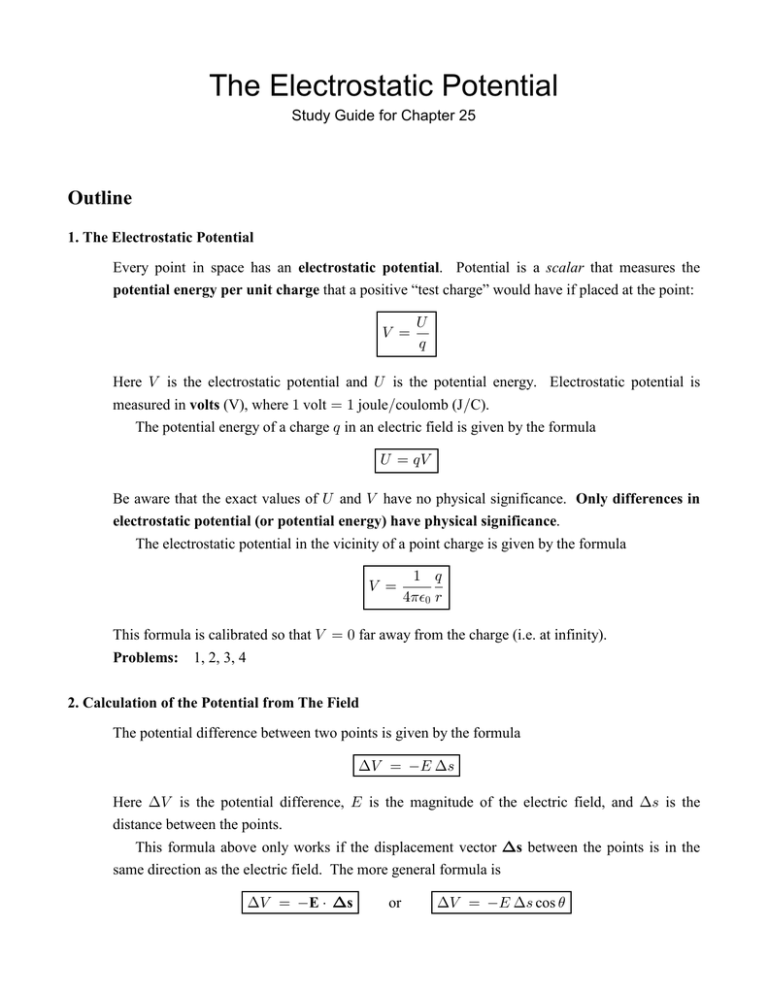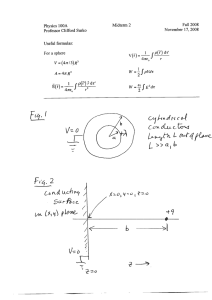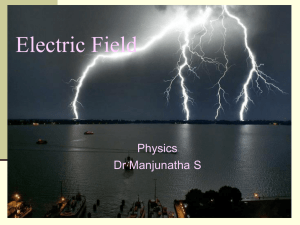Chapter 25 Study Guide
advertisement

The Electrostatic Potential Study Guide for Chapter 25 Outline 1. The Electrostatic Potential Every point in space has an electrostatic potential. Potential is a scalar that measures the potential energy per unit charge that a positive “test charge” would have if placed at the point: Z œ Y ; Here Z is the electrostatic potential and Y is the potential energy. Electrostatic potential is measured in volts (V), where " volt œ " jouleÎcoulomb (JÎC). The potential energy of a charge ; in an electric field is given by the formula Y œ ;Z Be aware that the exact values of Y and Z have no physical significance. Only differences in electrostatic potential (or potential energy) have physical significance. The electrostatic potential in the vicinity of a point charge is given by the formula Z œ " ; %1%! < This formula is calibrated so that Z œ ! far away from the charge (i.e. at infinity). Problems: 1, 2, 3, 4 2. Calculation of the Potential from The Field The potential difference between two points is given by the formula ?Z œ I ?= Here ?Z is the potential difference, I is the magnitude of the electric field, and ?= is the distance between the points. This formula above only works if the displacement vector ?s between the points is in the same direction as the electric field. The more general formula is ?Z œ E † ?s or ?Z œ I ?= cos ) All of these formulas assume that the electric field is uniform. In a nonuniform electric field, the potential difference between point T and point U is given by the formula ?Z œ ( U I .= T or more generally ?Z œ ( U E † ds T All the negative signs in these formulas indicate that Z decreases in the direction of E, like this: This section also discusses the potential created by continuous charge distributions (starting after example 5), but you do not need to worry about this material. Problems: 5, 6, 7 3. Potential in Conductors Because the electric field is zero inside a conductor, the potential difference between two points in a conductor is zero as well. It follows that any two points in the same conductor have the same electrostatic potential. 4. Calculation of the Field from the Potential An equipotential line (or equipotential surface) is a line (or surface) of constant potential. We often use equipotential lines to draw the potential in a region. The electric field can be determined from the potential by the formula I œ ?Z ?= or I œ .Z .= The electric field is always perpendicular to the equipotentials, and points from high potential to low potential. Problems: 8, 9, 10 5. Energy of Systems of Charges For a system of charges, the total potential energy is the sum of the potential energies for each pair of charges. The potential energy of a charged conductor is given by the formula Y œ " UZ # where U is the net charge of the conductor, and Z is the potential of the conductor. This section also discusses the energy density of an electric field (starting after example 13). You do not need to worry about this topic. Problems: 11, 12 Answers 1. @ œ #Þ' ‚ "!' mÎs 5. ?Z œ '! kV 3. Z œ !Þ$$ MV 6. ?Z œ "Þ) MV; the second point 8. I œ "Þ'( MVÎm 11. Y œ &% µJ 2. @ œ #Þ" ‚ "!& mÎs 9. E œ "& j kVÎm 12. Y œ "Þ( J 4. Z œ "' kV 7. ?Z œ *Þ! V 10. (a) point E (b) I œ #!! VÎm




